
I briefly considered writing about Mardi Gras today, but I just don’t like it enough. I am not a Carnival person. I don’t like the noise, the crowds, the mess, the stink. I hate feeling inebriated and I simply can’t tolerate drunk people. I have no use for plastic beads. And King Cake looks revolting.
So we’re going to do pancakes instead!
Mardi Gras means Fat Tuesday, or more precisely, Fat Mars-day. The Romans dedicated the second day of the week to the planet named for their war god, Mars. The closest Norse equivalent to Mars was Tyr, or Tiw. Hence it became Tuesday in English.
However, it’s the “fat” part that is more significant.
Christians fast in Lent which begins on Ash Wednesday, the morning after Mardi Gras. Not everyone follows the same dietary restrictions, but it was and still is common to give up meat and the fat that comes with it. Of course, there was not much meat to give up at this time of year for traditional cultures living in northern climates. So there may have been an element of making a virtue out of necessity. But the result of giving fat up for the six weeks of Lent is that what was in the pantry on Fat Tuesday had to be used up or it would go rancid.
There are many ways to use a large quantity of lard in one day, but there is one recipe that people turn to again and again — pancakes! In fact, eating griddle cakes in the spring may predate Lent. For example, in Scotland oatcakes have long been associated with Candlemas and seem to derive from the holiday’s agricultural traditions, not Christianity. Even today, pancakes and other fried dough disks are eaten with abandon at this time of year without any reference to the Lenten fast — though the best community pancake suppers happen on Fat Tuesday. And in New England Fat Tuesday often coincides with the perfect complement to pancakes — fresh maple syrup!
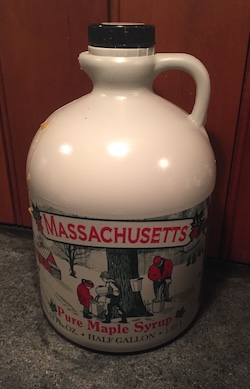
About this time of year the maple trees in our neighborhood become festooned in bright tubing. It isn’t as romantic as the old-timey, hanging-bucket pictures on all the syrup bottles, but it’s much easier to maintain and keep clean. The trees are tapped (meaning a small hole is drilled down to the inner bark) and a spile is inserted. The spile is connected to rubber hose that joins many trees together in a collection network. The sap runs through the tubing to a large tub that only needs emptying once or twice in a season, rather than every few hours as with the buckets at peak sap flow.
Of course, if you’re making your own syrup from a few trees — especially if your “sugar bush” consists of solitary trees spread over a large area — the buckets are better. Buckets are cheaper both to buy initially and to maintain. There is less material and energy use though you have to expend more energy. Still, the whole production is more human scale. The tapping process for buckets is the same, but the spile should have a hook on it to hold the bucket. Be prepared to empty your buckets often, and you’ll need to have clean storage containers to hold the sap until you have enough to boil down, “enough” being entirely up to you. It will take hours, perhaps a full day, to boil the sap into syrup no matter the sap volume. Get the most out of those hours by boiling it all at once.
Native Americans have been tapping and boiling maple sap for at least hundreds if not thousands of years. There is an ancient tale of Nanabozho, the Anishanaabe trickster, and maple syrup. Long ago, sap flowed from the maple trees as pure syrup, free sweetness for the taking. Nanabozho decided this was way too easy, that the people did not appreciate the free gift. He thought hard work would make the people more grateful. So he diluted the sap with water, leaving merely a trace of sweetness. The people then had to boil off the water to get to the sugar — quite a lot of water. It takes about 40 gallons of sap to make 1 gallon of syrup. Nanabozho truly made us work for that sweetness.
Native Americans made maple sugar from the sap, so they really cooked out all the water. They stored large blocks of the sugar in special birch-bark boxes. Sugar is easier to cook with, easier to transport and store, and I suspect it lasts longer than syrup — provided the ants can be kept out.
Incidentally, there are other trees that can be tapped for sweet sap, but maple is the most concentrated. For example it takes somewhere around 110 to 200 gallons of sweet birch sap to make a gallon of syrup. That said, if you’re up for the work and have access to a large number of trees, the taste is divine. It’s a softer sweetness with a minty overlay; it can only be described as winter air. You’re not likely to ever find it for sale. However, there are birch beers that will give you an impression of the syrup’s flavor.
Since tapping a tree is literally taking its life-blood, choose your sugar bush trees wisely. Tap mature trees, those with a diameter of at least a foot measured at a height of five feet above the ground. I’ve seen some old trees covered in buckets, but most people will drill no more than three holes per tree per year. When using the tube-collection method, there is normally just one insertion in the tree; and to my eyes it seems that these tap-holes are reused year to year though it’s commonly recommended that you drill at least 6” away from previous holes. In our sugar bush, the maple trees bear evidence of tapping all around the trunk; it doesn’t seem like the people who were here before us reused holes.
Sugar season is not set in time. It can begin as early as January or as late as the end of March. It’s the weather that is important. The trees need to experience warm days — a few degrees above freezing — so sap will flow. But nights must be cold. This daily variation in temperature creates pressure differentials which makes flow volumes that are high enough to keep the tap hole from drying and healing over. Further, once the tree starts photosynthesizing, the sap turns bitter. This bitterness is the tree’s defense from sap-suckers of all kinds, including us. So when the buds open, it’s definitely time to turn off the tap. It’s also said that when the spring peepers start singing, tapping season is over. Many sugar producers will finish the season with the so-named “frog run”, the last sap collected before spring begins in earnest.
This year, while the tubes and taps and collecting tubs are out and ready, the maple sap isn’t flowing just yet. It’s still too cold. So there won’t be that newly-boiled syrup, but — never fear! — we’ve got a half gallon of last year’s.
And now to the recipe. This comes from flap-jack master, Sean Anker, who has flipped uncountable pancakes, serving out delectable mountains of them whenever the mood strikes. This variation is special for Mardi Gras. It incorporates bourbon — but no beads. If you like, I suppose you could use food coloring to make them the traditional Mardi Gras jewel-toned purple, green and gold. But that’s on you.
Sean’s Bourbon Street Apple Pancakes
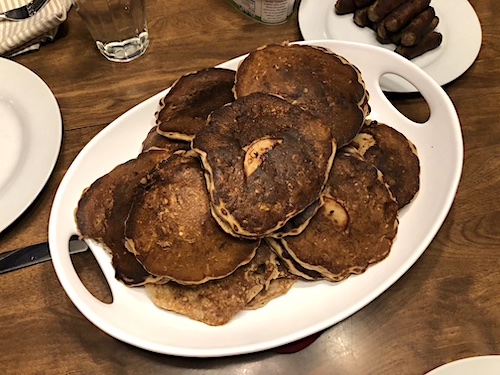
2 cups rolled oats 2 cups flour 4 tsp baking powder 2 tsp baking soda 1 tsp salt 1/2 tbs cinnamon 1/2 tsp allspice 1/4 tsp clove 1/8-1/4 tsp mace 2 tbs sugar (or maple sugar) 2 tbs brown sugar
2 cups chopped apple 5-6 tbs bourbon ~1 tsp cinnamon (to taste) 4 eggs 1/2 cup canola oil (or other fat, see below) 2 cups plain yogurt 1-2 tbs rice vinegar ~ 2 cups milk to fill (see below)
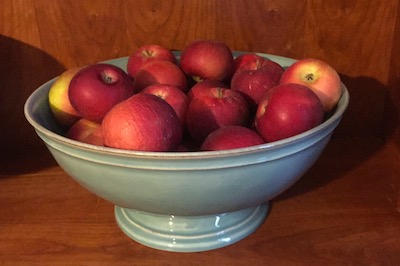
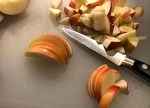
Chop up the apples and set them to sousing — put them in a bowl with 5-6 tbs bourbon and 1 tsp cinnamon. Use Jack Daniel’s Tennessee Honey or a similar bourbon with a sweet edge. Keep spooning the bourbon/cinnamon mix over the apples while you’re prepping the rest.

A note: the apples don’t have to be too fresh. In fact, it is better to use slightly drier fruit both to absorb more alcohol and to keep the batter from turning runny. You can use the wrinkled things from the cold cellar. Or you can use dried apples or fruit leather. Chop these somewhat finer than fresh apples to increase surface area absorption.
Next, prep the yogurt/milk mix. Put 2 cups yogurt in a 4 cup measuring cup. Add 1 tbs rice vinegar and stir it up. You should taste the bite of the acid. If not, add one more tablespoon of vinegar and then fill up to the 4 cup mark with milk. Mix it all together and let it sit. It should froth up a bit after a few minutes.
Preheat your cook surface over medium heat. A griddle is highly recommended for this volume of pancake frying. With a smaller pan, it will take 2-3 times as long.
If your oven has a warm setting, put a platter inside and warm it up. If there is no warm setting, just put the platter in with the oven off and use a flour-sack towel for insulation. You’ll put the pancakes in here as they come off the griddle.
Mix the dry ingredients in one bowl. Use your nose to make sure the spice mixture complements the soused apples.
Beat the four eggs in another bowl until frothy. Add 1/2 cup oil and beat it some more. You can substitute in whatever fat you like — canola is fairly neutral. Melted and slightly browned butter is divine but can be a bit heavy for this recipe. A half-and-half mix might be good. Or if you want to go full traditional, get out the lard, but reduce the amount used to about 1/3 cup. When the egg mixture is well beaten, add the 4 cup of milk/yogurt mixture and mix well. If you still have pent up aggression (and a large enough bowl) feel free to beat it some more.

Pour the wet mixture into the dry mix. Use a spoon to gently blend them together. Small flour pockets in the batter are acceptable. You want a reasonably thick batter after mixing – not runny. Spoon in more flour if the mix is wet, or add some milk if it’s dry.
Use a slotted spoon to transfer the apples to the batter. Do not pour in the bourbon. If you want to souse some slices to top your pancakes, now is the time to put them into the bourbon/cinnamon mix.
Stir in the apples gently but thoroughly. Then let the whole mix sit for a few minutes.
If you are cooking sausages or some other complementary protein thing, start that now.

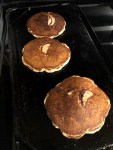
Use a 1/3 cup measure to pour the batter onto a medium-hot griddle. A griddle can accommodate about 3 of these pancakes at a time. When the surface bubbles pop but don’t collapse, flip the pancakes. They are done when the sides look solid with air pockets. When done, move to the warming platter and repeat until you run out of batter.
This recipe will make 2-3 dozen pancakes.
Serve with butter and syrup and some salty protein thing of your choice.
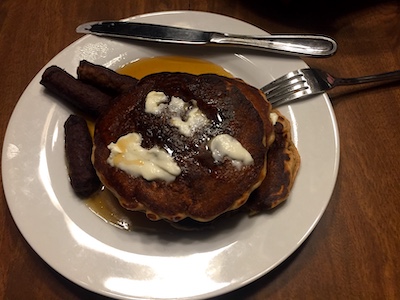
This recipe may not be suitable for kids; the alcohol won’t cook off completely.
©Elizabeth Anker 2021

[…] but there is no International House of Flapjacks, so I’ll stick to calling them pancakes. I have this recipe. But for summer, I like using fresh seasonal fruit on top. I also like adding chopped nuts and […]
LikeLike
[…] but there is no International House of Flapjacks, so I’ll stick to calling them pancakes. I have this recipe. But for summer, I like using fresh seasonal fruit on top. I also like adding chopped nuts and […]
LikeLike